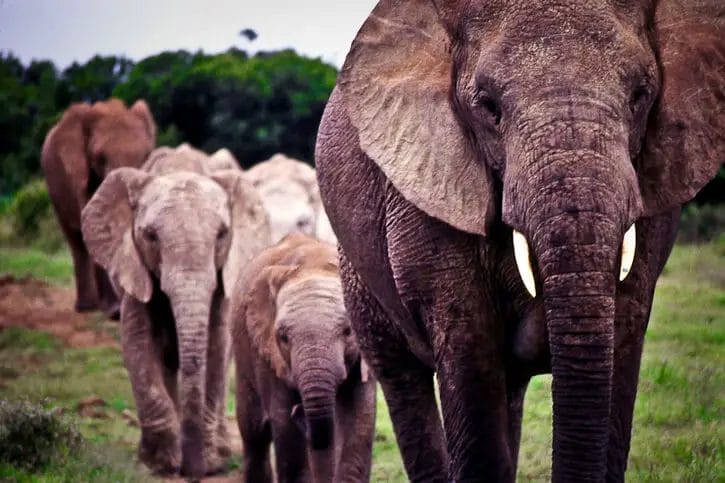Elephants are one of the most iconic and beloved animals in the world. They are the largest land animal on Earth, and their size, intelligence, and social dynamics make them fascinating to study and observe.
In this article, we will explore what we can learn from elephants by examining their physical characteristics and behaviors, conservation and ecological impact, and cultural and historical significance.

Physical Characteristics and Behaviors
Elephants are known for their large size and distinctive features, such as their long trunks, large ears, and thick skin. They can weigh up to 6,000 kg and stand up to 4 meters tall at the shoulder.
Their trunks are incredibly versatile, used for everything from grasping food to communicating with other elephants.
Their large ears also serve a purpose, being used to regulate body temperature and also to communicate with other elephants through vocalizations, such as trumpets and rumbling.
Elephants are also known for their highly social and intelligent behaviors. They live in complex social groups, or herds, led by a dominant female, known as the matriarch.
These herds can have up to 100 individuals and have a complex system of communication and cooperation. Elephants have also been observed using tools, such as using branches to swat flies, and exhibiting empathy towards each other.
This high level of intelligence and social complexity is one of the reasons elephants are considered a keystone species.
Conservation and Ecological Impact
Elephants play an important role in shaping and maintaining the ecosystems in which they live. However, elephant populations have been in decline for decades due to habitat loss and poaching for their ivory tusks.
According to the IUCN, African elephants are listed as vulnerable, and Asian elephants are listed as endangered. Efforts to conserve elephant populations have been ongoing for many years, but they face many challenges.
Habitat loss and fragmentation continue to be major issues, as elephants require large areas of land to roam and forage. In addition, poaching for ivory remains a major threat.
The ecological impact of elephants is significant. They are known as ecosystem engineers, meaning that their activities shape the landscape and influence the distribution of other species.
For example, elephants can help to maintain savannahs by knocking down trees and creating openings for new growth. They also help to disperse seeds and maintain waterholes.

Cultural and Historical Significance
Elephants have been revered and celebrated in human cultures for thousands of years. In many cultures, they are symbols of strength, wisdom, and good luck.
Elephants have been depicted in art and literature throughout history, and they continue to be popular subjects in contemporary culture.
Elephants have also played an important role in human history. They have been used for transportation and labor for centuries, and they have been trained for use in war and entertainment.
The use of elephants in circuses and other forms of entertainment has been a controversial issue, with many animal welfare groups calling for an end to the practice.
In conclusion, elephants are fascinating and complex animals that have much to teach us about the natural world and our place in it. They are also an important part of human culture and history.
In the next half of the article, we will delve deeper into these topics and reflect on the importance of understanding and preserving these magnificent animals.
How do elephants communicate with each other?
Elephants have a complex system of communication, which includes vocalizations, body language, and chemical signals. They use trumpets, rumbles, and other vocalizations to communicate with each other over long distances.
They also use their trunks to touch and smell each other, which can convey information about their mood and reproductive status.
How do elephants maintain their population?
Elephants have a long reproductive cycle, with females giving birth every 2-4 years. They also have a relatively low birth rate, with most females only having 2-3 offspring in their lifetime.
This, combined with habitat loss and poaching, has led to a decline in elephant populations in recent years.
How do elephants play a role in shaping and maintaining the ecosystem?
Elephants are known as ecosystem engineers, meaning that their activities shape the landscape and influence the distribution of other species. For example, elephants can help to maintain savannahs by knocking down trees and creating openings for new growth. They also help to disperse seeds and maintain waterholes.
How do elephants use tools?
Elephants have been observed using tools in the wild, such as using branches to swat flies, and using logs to cross ditches. They also use their trunks to get food, by grasping and manipulating objects.
This is an example of their intelligence, and it has been also observed in captivity.

How can I support elephant conservation?
There are several ways to support elephant conservation efforts, including:
- Supporting organizations that are working to protect elephant populations and habitats
- Not purchasing products made from elephant ivory
- Being informed and speaking out against elephant abuse in entertainment
- Educating others about the importance of preserving elephant populations and habitats.
